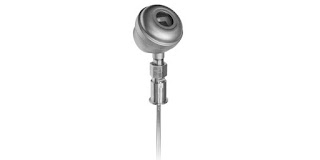 |
| A special version of the Magnetrol Eclipse 705 is configured for hygienic applications. Image courtesy Magnetrol |
Measurements of a variety of process conditions are utilized to monitor and control operations and output. One general goal of measurement, other than answering the question "how much", is to avoid or minimize any interference with the process itself. A second goal is to not be fooled by the process into returning a false measurement result.
Guided wave radar (GWR), as opposed to an open style radar level measurement method, uses a probe immersed in the process media to guide high-frequency electromagnetic waves into the media being measured. While it does involve contact by the sensing instrument with the media, GWR eliminates interference from fixtures or structures that may exist within the tank or vessel. The immersion probe waveguide also attenuates the impact of media turbulence and other potential disturbances. The waveguide reduces the potential impact of elements that may adversely impact the measurement accuracy, resulting in greater accuracy and reliability of the measurements.
For hygienic applications, the transmitters are available with 304 stainless steel housings designed specifically for use in facilities with the special requirements for the wetted and non-wetted materials, process connections and surface finishes of hygienic industries. In addition to high accuracy, the GWR instrument output is not impacted by media buildup on the sensing probe.
For hygienic applications, the transmitters are available with 304 stainless steel housings designed specifically for use in facilities with the special requirements for the wetted and non-wetted materials, process connections and surface finishes of hygienic industries. In addition to high accuracy, the GWR instrument output is not impacted by media buildup on the sensing probe.
Share your level measurement challenges with process instrumentation specialists. Leverage your own process knowledge and experience with their product application expertise to develop an effective solution.
